
Hibbertia stellaris, commonly known as star guinea flower or orange stars, is a brilliantly orange flowering ground cover from the South Western Australian botanical province. It naturally grows in swamps; despite this, it is extremely sensitive to phytophthora and needs to be grown in well-drained soil in cultivation.
Seringia integrifolia, commonly known as common firebush, is a species of flowering plant in the family Malvaceae and endemic to the south-west of Western Australia. It is a compact shrub, its new growth densely covered with star-shaped hairs, and has mostly narrowly leaves and many deep blue to purple flowers arranged in groups of 4 to 10.

Hibbertia commutata is a species of flowering plant in the family Dilleniaceae and is endemic to the south-west of Western Australia. It is a low, erect, many-branched shrub with narrow elliptic to narrow egg-shaped leaves, and yellow flowers with fifteen to thirty stamens arranged around three carpels.

Hibbertia depressa is a species of flowering plant in the family Dilleniaceae and is endemic to the far south-west of Western Australia. It is a prostrate or sprawling shrub with spreading, usually densely clustered, linear leaves and yellow flowers arranged singly or clustered among the leaves.

Styphelia crassifolia is a species of flowering plant in the family Ericaceae and is endemic to [the south-west of Western Australia. It is an erect, bushy shrub that typically grows to a height of 60 cm (24 in). Its leaves are oblong, 4–9 mm (0.16–0.35 in) long on a short petiole, with 3 prominent ribs on the lower surface. One or two flowers are borne in leaf axils on a short peduncle with tiny bracts and bracteoles about half the length of the sepals. The sepals are about 1.6 mm (0.063 in) long and the petals are about 3.2 mm (0.13 in) long and joined at the base, the lobes about as long as the tube.

Hibbertia desmophylla is a species of flowering plant in the family Dilleniaceae and is endemic to the south-west of Western Australia. It is a sprawling or erect, hairy shrub with spreading, densely clustered, linear leaves and yellow flowers with eleven to thirteen stamens.
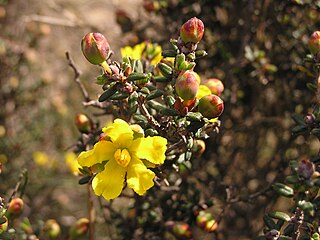
Hibbertia exasperata is a species of flowering plant in the family Dilleniaceae and is endemic to the south-west of Western Australia. It is an erect or straggling shrub that typically grows to a height of 10–60 cm (3.9–23.6 in) with sharply-pointed leaves. It has yellow flowers from June to October and grows on low ridges and sandplains. It was first formally described in 1845 by Ernst Gottlieb von Steudel in Johann Georg Christian Lehmann's Plantae Preissianae and was given the name Candollea exasperata. In 1900, John Isaac Briquet changed the name to Hibbertia exasperata. The specific epithet (exasperata) means "rough, with short, hard points", referring to the leaves.
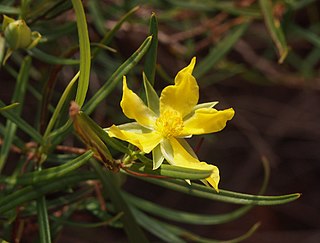
Hibbertia glaberrima is a species of flowering plant in the family Dilleniaceae and is endemic to Central Australia. It is a glabrous, spreading shrub with oblong to lance-shaped leaves and yellow flowers borne singly in upper leaf axils, with 30 to 150 stamens arranged around three carpels.
Hibbertia goyderi is a species of flowering plant in the family Dilleniaceae and is endemic to the Northern Territory. It is a small leafless shrub with angular stems and yellow flowers with about nine or ten stamens arranged around the two carpels.

Hibbertia hemignosta is a species of flowering plant in the family Dilleniaceae and is endemic to the south-west of Western Australia. It is a prostrate to erect shrub that typically grows to a height of 30–50 cm (12–20 in). It was first formally described in 1845 by Ernst Gottlieb von Steudel who gave it the name Pleurandra hemignosta in Lehmann's Plantae Preissianae. In 2002, Judy Wheeler changed the name to Hibbertia hemignosta in Journal of the Adelaide Botanic Gardens. The specific epithet (hemignosta) means "half-known", but the reason for that name was not given. This hibbertia grows on sandplains, flats and slopes in the Avon Wheatbelt, Coolgardie, Esperance Plains, Jarrah Forest, Mallee, Swan Coastal Plain and Warren biogeographic regions in the south-west of Western Australia.

Hibbertia hibbertioides is a species of flowering plant in the family Dilleniaceae and is endemic to near-coastal areas of south-western Western Australia. It is a small, prostrate or sprawling shrub with crowded, linear cylindrical leaves and yellow flowers with usually eleven stamens arranged in groups around three carpels.

Hibbertia huegelii is a species of flowering plant in the family Dilleniaceae and is endemic to the south-west of Western Australia. It is an erect, spreading or prostrate shrub with hairy branchlets, linear leaves and yellow flowers arranged singly in leaf axils on the ends of shoots, with fifteen to twenty-five stamens in bundles around the four or five carpels.
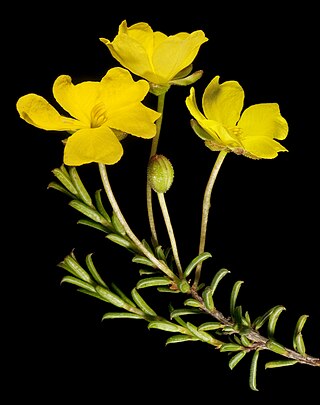
Hibbertia lineata is a species of flowering plant in the family Dilleniaceae and is endemic to the south-west of Western Australia. It is a spreading to erect shrub with linear to narrow egg-shaped leaves and yellow flowers, usually with ten stamens arranged on one side of, and leaning over the two densely hairy carpels.
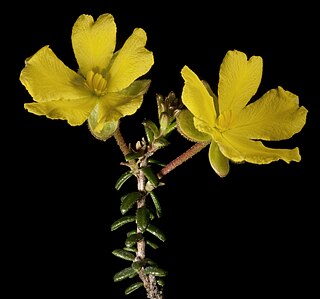
Hibbertia microphylla is a species of flowering plant in the family Dilleniaceae and is endemic to the south-west of Western Australia. It is a shrub with weakly ascending stems, broadly egg-shaped to elliptic leaves and yellow flowers, usually with ten stamens and up to nine staminodes arranged on one side of, and leaning over the two densely hairy carpels.
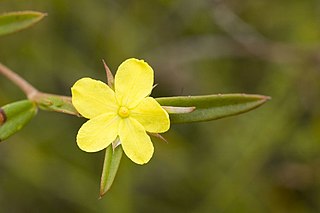
Hibbertia salicifolia is a species of flowering plant in the family Dilleniaceae and is endemic to eastern Australia. It is a shrub with loose reddish bark, linear to oblong leaves and yellow flowers with the stamens arranged all around the carpels.
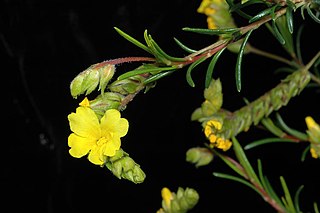
Hibbertia spicata is a species of flowering plant in the family Dilleniaceae and is endemic to the west of Western Australia. It is a low, erect to spreading shrub with scattered linear leaves with the edges rolled under and yellow flowers with six or seven stamens on one side of two softly-hairy carpels, and a larger number of staminodes.

Hibbertia striata is a species of flowering plant in the family Dilleniaceae and is endemic to the southwest of Western Australia. It is a spreading shrub with linear leaves and yellow flowers usually with thirty stamens arranged in five bundles around five glabrous carpels.

Hibbertia montana is a species of flowering plant in the family Dilleniaceae and is endemic to the south-west of Western Australia. It is an erect, straggling or sprawling shrub with densely hairy foliage, narrow oblong leaves, and pedunculate yellow flowers with thirty to sixty stamens and a few staminodes arranged around velvety carpels.

Hibbertia pilosa, commonly known as hairy guinea flower, is a species of flowering plant in the family Dilleniaceae and is endemic to the southwest of Western Australia. It is an erect or sprawling shrub that typically grows to a height of 0.3–1.5 m and has leaves with long, soft hairs. The flowers are yellow with one or two densely hairy carpels from September to December. The species was first formally described in 1845 by Ernst Gottlieb von Steudel in Lehmann's Plantae Preissianae. The specific epithet (pilosa) means "pilose", referring to the leaves.
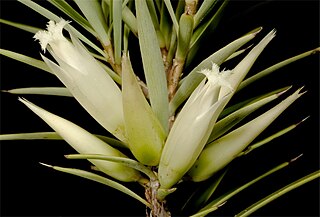
Styphelia macrocalyx, commonly known as Swan berry, is a species of flowering plant in the heath family Ericaceae and is endemic to the south west of Western Australia. It is a shrub with sharply pointed, narrowly lance-shaped leaves and white, tube-shaped flowers with tufts of hairs on the inside.


















